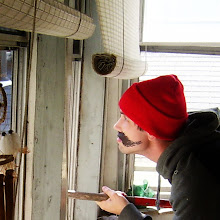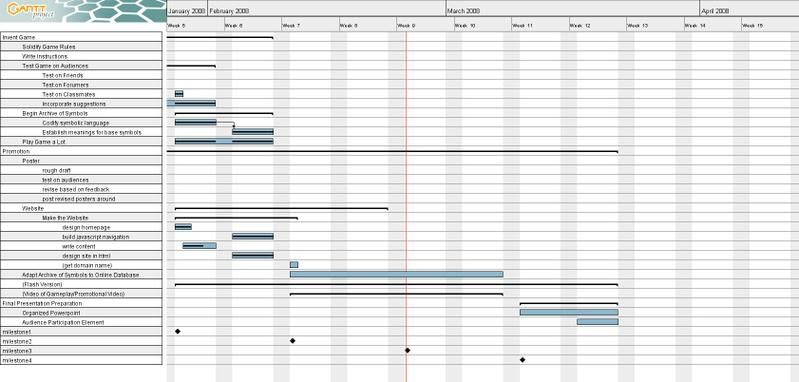Monday, April 14, 2008
Monday, March 31, 2008
non-broken swf test file
Here's a non-broken flash test. It illustrates the basic functions in my broken file, but in a not-broken kinda way.
will it work...?
will it work...?
adventures with actionscript3
Here's a broken flash file:
cockadoodledoo
This would have been working fine if I had not made a really stupid mistake. More on that later...
cockadoodledoo
This would have been working fine if I had not made a really stupid mistake. More on that later...
"testData"
Playability:
The ease of gameplay. Is it easy to learn and play without too much instruction? Is the gameplay challenging?
Interest:
How interesting is the game itself? Does it stimulate your mind/penis/vagina?
Relevance:
How relevant is the game to the philosophy/book? (Note: I’ve never been able to describe this philosophy/book effectively)
Potential:
One of the main aspects of my game concept is expandability--how would you rate the potential expansion of these games.
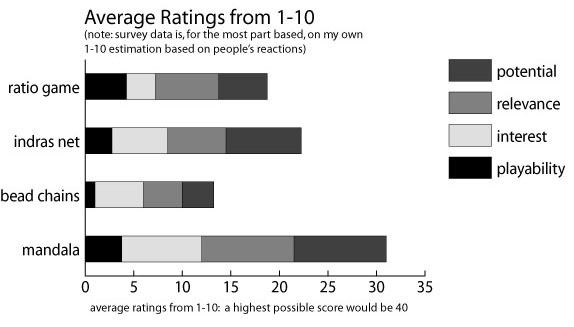
Additional Comments:
ratio game: -the connection to the book/philosophy is unclear
-the game isn’t fun to play
indras net: -I-Ching connection is good
-basic gameplay is far too simple and not very “game” like
bead chains: -far too complex, almost impossible to learn
-as an extension of the ratio game, it makes the connection to the
book/philosophy more apparent.
Mandala: - game interface is too hard to manipulate
-make it with flash.
The ease of gameplay. Is it easy to learn and play without too much instruction? Is the gameplay challenging?
Interest:
How interesting is the game itself? Does it stimulate your mind/penis/vagina?
Relevance:
How relevant is the game to the philosophy/book? (Note: I’ve never been able to describe this philosophy/book effectively)
Potential:
One of the main aspects of my game concept is expandability--how would you rate the potential expansion of these games.

Additional Comments:
ratio game: -the connection to the book/philosophy is unclear
-the game isn’t fun to play
indras net: -I-Ching connection is good
-basic gameplay is far too simple and not very “game” like
bead chains: -far too complex, almost impossible to learn
-as an extension of the ratio game, it makes the connection to the
book/philosophy more apparent.
Mandala: - game interface is too hard to manipulate
-make it with flash.
Saturday, March 15, 2008
the dust is settling
The time has come to surrender my grandiose notions and settle for mediocrity. Over this vacation I haven’t had any time to think about my project, let alone do anything with it. Furthermore, I will not have time in the coming weeks to implement any potentially brilliant ideas for the same reason I haven’t been able to work on it this vacation—that is, my internship/independent study. All I can do is fulfill and realize the ideas I’ve already come up with. And it isn’t that I haven’t come up with anything; in fact, I’ve come up with quite a lot that is essentially what one might call “innovative.” The problem is in how these new ideas are applied and presented.
Monday, February 25, 2008
link to website
link
The next step is to add pictures, maybe videos too if they help. Beyond this there is the collaboration I'm seeking with Fractiles-7, as well as with some musicians who dabble in process composition.
The next step is to add pictures, maybe videos too if they help. Beyond this there is the collaboration I'm seeking with Fractiles-7, as well as with some musicians who dabble in process composition.
Wednesday, February 20, 2008
Sunday, February 17, 2008
a wild idea
I've been entertaining the idea of proposing this game, once it exists, to the fractiles-7 company (the company that produces the pattern pieces I use for the game board). On the packaging of their game they have a lot of different ideas for patterns, along with some educational bits about the number seven and nature.
I think that the connection they highlight between math, visual patterns, and nature is a perfect connection to the fundamental philosophy of the glass bead game; and I can easily see the inclusion of some simple game rules to accompany their pattern ideas.
I think that the connection they highlight between math, visual patterns, and nature is a perfect connection to the fundamental philosophy of the glass bead game; and I can easily see the inclusion of some simple game rules to accompany their pattern ideas.
Monday, February 11, 2008
I Ching symbol meanings
here's a strange website I found that, despite its garish appearance, has a ton of information regarding the I Ching, and most importantly, has the interpretations of each trigram and hexagram combination-->link
I will be using the I Ching to interpret game results
I will be using the I Ching to interpret game results
no money

here is some evidence I've forged to give the impression I've been toiling away faithfully on this project:
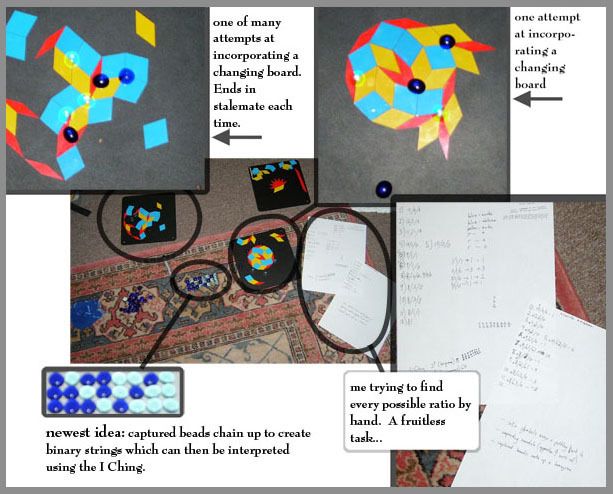
Sunday, February 10, 2008
website, 90's style
Here's the temporary location of my website: link
I think a layout reminiscent of geocities is perfect, don't you agree?
I think a layout reminiscent of geocities is perfect, don't you agree?
del.icio.us: kriegspiel
link
The most distinctive aspect of my glass bead game is, I think, in the board itself. Instead of being simply a surface on which to play/fight, the board is deeply and connected with the gameplay of each different game because of its potential for unique situations.
I think Kriegspiel and many other games are able to have such elaborate rules and situations because of their solid foundation--the game board. My game board is hectic and possibly confusing; some patterns might be seen while others are unnoticed, some possibilities explored and elaborated on, while others are looked over. In other games the board is taken for granted and the possibilities are well known and considered even before a game has started.
This brings me back to the idea that perhaps the goal of the game should be to organize the board. It's not only appropriate to the philosophy of the game in the book, but the process of reordering by finding connections is analogous to the process of meditation--concerning the transformation of the mind.
The only problem is it's incredibly cumbersome and difficult to reorganize the game board while playing, not to mention the rules I've come up with to do so are confusing even to myself.
The most distinctive aspect of my glass bead game is, I think, in the board itself. Instead of being simply a surface on which to play/fight, the board is deeply and connected with the gameplay of each different game because of its potential for unique situations.
I think Kriegspiel and many other games are able to have such elaborate rules and situations because of their solid foundation--the game board. My game board is hectic and possibly confusing; some patterns might be seen while others are unnoticed, some possibilities explored and elaborated on, while others are looked over. In other games the board is taken for granted and the possibilities are well known and considered even before a game has started.
This brings me back to the idea that perhaps the goal of the game should be to organize the board. It's not only appropriate to the philosophy of the game in the book, but the process of reordering by finding connections is analogous to the process of meditation--concerning the transformation of the mind.
The only problem is it's incredibly cumbersome and difficult to reorganize the game board while playing, not to mention the rules I've come up with to do so are confusing even to myself.
del.icio.us: mediocrity
link
Ha ha ha ha
I think I might try playing this game next time I'm at the beach; I imagine it would be a more charming way to pass the time than bemoaning (to my entirely unsympathetic friends) the importance of "success" and my complete lack of motivation to accomplish anything in my life.
I wonder if the numbers are chosen randomly, or if each player is supposed to simply hide their choice in number...and what happens when two people have the same number, or is there some way to prevent this from happening...
Ha ha ha ha
I think I might try playing this game next time I'm at the beach; I imagine it would be a more charming way to pass the time than bemoaning (to my entirely unsympathetic friends) the importance of "success" and my complete lack of motivation to accomplish anything in my life.
I wonder if the numbers are chosen randomly, or if each player is supposed to simply hide their choice in number...and what happens when two people have the same number, or is there some way to prevent this from happening...
Wednesday, January 30, 2008
Difficulty expanding on the basic rules
The biggest difficulty in creating a non-computer reliant version of this game has been in the incorporation of a meaningful end-game condition.
In class, it was apparent that the game lacked a strong enough connection to the philosophy that the game is supposed to model. To fix this I've come up with an idea, but its incorporation into the game initially appears very difficult.
The idea would change the goal of the game from winning points (never seriously considered) to ordering the board, which would bring the focus of the game to the two main concepts of the philosophy: creating order by finding connections. The difficulty is that this could make the game very frustrating, or impossible. It also ruins the idea of having a "print-out" of the game board since the board would be changing.
The idea (still in cloudy form):
In the current rules (see below), finding a connection (same ratio symbol as opponent) gives you a point and gives you your opponent's bead. In this idea, instead of getting their bead you would get the symbol under their bead. Acquired symbols would be like a player's bag of tricks; if an opponent puts a bead on a space that has a unique ratio (or whatever the "connecting" criteria is), the player might be able to place their symbol back onto the board in such a way that it creates a connection for them.
Theoretically this works wonderfully, and philosophically it's solid as solid can be, but the nitty-gritty rules that make it work could be very confusing or difficult to satisfy in-game. I can see this addition to the game making the game last forever, which is good and bad; good because that's accurate to the book--the games could go on for weeks--and bad because it might dissuade people from playing.
*tangent: if this is the case, and the game lasts forever, an internet version of the game would be ideal. I'm thinking about those flash games where 100's of people try to spell a word on a virtual refrigerator door. Similarly, the game might be played in real time, with the board changing and pieces flying everywhere, the goal being to create your own patterns, or to create one pattern cooperatively.*
I suppose the next step is to try out this idea and work out the nitty-gritty rules of it.
In class, it was apparent that the game lacked a strong enough connection to the philosophy that the game is supposed to model. To fix this I've come up with an idea, but its incorporation into the game initially appears very difficult.
The idea would change the goal of the game from winning points (never seriously considered) to ordering the board, which would bring the focus of the game to the two main concepts of the philosophy: creating order by finding connections. The difficulty is that this could make the game very frustrating, or impossible. It also ruins the idea of having a "print-out" of the game board since the board would be changing.
The idea (still in cloudy form):
In the current rules (see below), finding a connection (same ratio symbol as opponent) gives you a point and gives you your opponent's bead. In this idea, instead of getting their bead you would get the symbol under their bead. Acquired symbols would be like a player's bag of tricks; if an opponent puts a bead on a space that has a unique ratio (or whatever the "connecting" criteria is), the player might be able to place their symbol back onto the board in such a way that it creates a connection for them.
Theoretically this works wonderfully, and philosophically it's solid as solid can be, but the nitty-gritty rules that make it work could be very confusing or difficult to satisfy in-game. I can see this addition to the game making the game last forever, which is good and bad; good because that's accurate to the book--the games could go on for weeks--and bad because it might dissuade people from playing.
*tangent: if this is the case, and the game lasts forever, an internet version of the game would be ideal. I'm thinking about those flash games where 100's of people try to spell a word on a virtual refrigerator door. Similarly, the game might be played in real time, with the board changing and pieces flying everywhere, the goal being to create your own patterns, or to create one pattern cooperatively.*
I suppose the next step is to try out this idea and work out the nitty-gritty rules of it.
Monday, January 28, 2008
Basic Game Rules *trumpets sound*
Basic Game Rules:
Setup:
-take 7 of each of the three shapes and make a small, 21 piece mandala (14 sided polygon). For example:

-player 1 starts with 4 dark beads
-player 2 starts with 3 light beads
-player 1 goes first
first round:
-player 1 places a bead on any intersection on the board
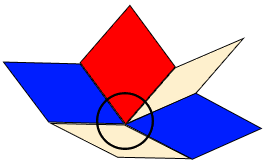
-player 2 places a light bead on an open intersection on the board, attempting to match player 1’s ratio of shapes (in the example above, the ratio of player 1’s intersection is 2/2/1 because it has two blue, two white, and 1 red shape). An exact match doesn’t count.
-if player 2 is successful, they take the bead of their opponent off the board and into their own hand. The space in which the bead sat cannot be used for 1 turn (note, this rule can change in larger versions of the game to say that the space cannot be used for the rest of the game). Player 2 gets a point.
-if player 2 is not successful, no beads are taken away and nobody gets a point. It becomes player 1’s turn again. Player 1 will then do the same as player 2, attempting to match player 2’s intersection ratio.
Strategies and other things to note:
-if a player puts a bead down and their opponent has multiple beads on the board with that same ratio, the player will take all of their opponents beads that match that ratio, and gain 1 point for each capture.
-captured beads are playable and they work in play as if your opponent had played them—any captured beads (captured beads will be your own color) will go to your opponent and your opponent will gain 1 point for any bead you capture for them.
-At the end of the game—when a player has run out of beads—any remaining beads in hand will be counted as either 1 point gained or subtracted (for every bead of your opponent you lose 1 point, for every bead of your own you gain 1 point). The player with the most points wins.
pattern notation
I've come up with a weird pattern notation scheme that can be used to record played patterns in the game. It's a bit hard to explain in words, so I'll make a diagram:
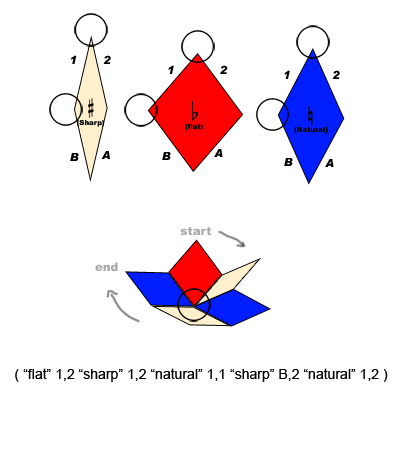
The three different shapes are labeled "sharp" "flat" and "natural" (referencing music notation). The four sides of each shape are labeled 1, 2, A, B going clockwise. The position of the bead determines where the starting point is, as pictured in the diagram.
Weee fun fun fun

The three different shapes are labeled "sharp" "flat" and "natural" (referencing music notation). The four sides of each shape are labeled 1, 2, A, B going clockwise. The position of the bead determines where the starting point is, as pictured in the diagram.
Weee fun fun fun
Sunday, January 27, 2008
brainstrom
This past week I've been brainstorming like mad. My notebook is half full with just about every idea I've had for this game, arranged in a manner that makes it completely inaccessible. However, in doing this I've really solidified the philosophy behind this game, and entertained a huge number of possibilities in gameplay that I may use later as I begin developing more versions of the basic game.
Writing this is hindsight is a bit weird considering I know the future. Should I whinge on about how I'll never come up with this blasted "basic game," or should I tell my past self that it will all come to pass; that yes, you will come up with a basic game that could possibly incorporate these ideas you are having, that it will all be ok and Jon won't fail you? Well, still waiting on that one...
please don't fail me.
In other news, I came up with a strange way to get myself into action in my depressed state. I pretend I'm someone else and do what they would do in my situation. I pretended I was a girl named Aubrey. She's a go-get-'em type with big ideas, big dreams, and a big capacity to plow through loads of exhausting work. It's not exactly that I pretend I'm this person, but I think it sounds funnier if I just leave it at that...
*turns into Aubrey*
toodles :)
Writing this is hindsight is a bit weird considering I know the future. Should I whinge on about how I'll never come up with this blasted "basic game," or should I tell my past self that it will all come to pass; that yes, you will come up with a basic game that could possibly incorporate these ideas you are having, that it will all be ok and Jon won't fail you? Well, still waiting on that one...
please don't fail me.
In other news, I came up with a strange way to get myself into action in my depressed state. I pretend I'm someone else and do what they would do in my situation. I pretended I was a girl named Aubrey. She's a go-get-'em type with big ideas, big dreams, and a big capacity to plow through loads of exhausting work. It's not exactly that I pretend I'm this person, but I think it sounds funnier if I just leave it at that...
*turns into Aubrey*
toodles :)
Tuesday, January 22, 2008
Depression sets in
Yes. Depression, my old friend, has returned at a most opportune time.
Can't get out of bed, can barely stand to think about anything at all, but when I try meditating I can't stop thinking. Can't sleep. Can't do work, even if it's due, which has always been something to kick my ass into gear. How will I ever complete this semester with all this independence?
How!?
Can't get out of bed, can barely stand to think about anything at all, but when I try meditating I can't stop thinking. Can't sleep. Can't do work, even if it's due, which has always been something to kick my ass into gear. How will I ever complete this semester with all this independence?
How!?
Game distribution
I've been thinking about how I would like to distribute this game, and I think Joe gave me a good direction in class the other day.
Rather than making a complete Flash Version of the game, or asking people to buy the pieces from Fractiles, I could make a simple construction set where people could arrange a new board, print it out, and play. Assuming I come up with a game for them to play...
Rather than making a complete Flash Version of the game, or asking people to buy the pieces from Fractiles, I could make a simple construction set where people could arrange a new board, print it out, and play. Assuming I come up with a game for them to play...
game development
still in development.
I would have liked to have the game concept completely flushed out by now, but the last element of the game still eludes me. I've come up with about a billion variations, but most of them play more like a process piece than a game. Right now I'm focusing on how I can make this a fun game but still firmly attached to the philosophical concepts it illustrates whilst implementing a simple, unique and almost entirely new style of gameplay.
Repeatedly, I've come to the question of what the "goal" of the game is, because it certainly isn't whoever-gets-the-most-points-wins or any other typical game condition I can think of. Recently though, I came up with the idea to have the game conclude in a place where it can begin again, making the game into a sort of circle.
I think I need to pretend I know how the game works completely, and just play it most to see where the faults are.
I would have liked to have the game concept completely flushed out by now, but the last element of the game still eludes me. I've come up with about a billion variations, but most of them play more like a process piece than a game. Right now I'm focusing on how I can make this a fun game but still firmly attached to the philosophical concepts it illustrates whilst implementing a simple, unique and almost entirely new style of gameplay.
Repeatedly, I've come to the question of what the "goal" of the game is, because it certainly isn't whoever-gets-the-most-points-wins or any other typical game condition I can think of. Recently though, I came up with the idea to have the game conclude in a place where it can begin again, making the game into a sort of circle.
I think I need to pretend I know how the game works completely, and just play it most to see where the faults are.
Tuesday, January 15, 2008
Subscribe to:
Posts (Atom)
